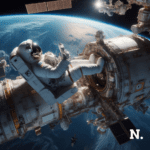Russia recently launched its first moon-landing spacecraft in 47 years. This marks their entry into a competitive race. The United States, China, and India are also exploring the moon’s resources. Russia is contemplating a cooperative crewed trip with China. They are also considering the possibility of a lunar outpost. Russia has plans for more lunar missions in the future. But what exactly is driving these major powers to invest heavily in lunar exploration?
The Moon: Role and Origin
The moon, located 384,400 km (238,855 miles) from Earth, plays a critical role in stabilizing the Earth’s axial wobble, which in turn ensures a more stable climate. Additionally, the moon is responsible for causing tides in the world’s oceans. Scientists believe the moon was formed about 4.5 billion years ago when a massive object collided with Earth, causing debris to come together and form the moon. The moon experiences extreme temperature variations, rising to 127 degrees Celsius in full sunlight and plummeting to about minus 173 degrees Celsius in darkness. Its exosphere offers no protection against solar radiation.
Water: A Crucial Discovery
The first definitive discovery of water on the moon was made by India’s Chandrayaan-1 mission in 2008. It detected hydroxyl molecules spread across the lunar surface. These molecules were concentrated at the poles, according to NASA. Water is necessary for human survival. It may also contain oxygen and hydrogen. These elements are needed to make rocket fuel. This discovery has significant implications for sustaining long-term human presence on the moon.
Helium-3: A Potential Energy Source on Moon
Helium-3, an isotope of helium, is scarce on Earth. It is, however, abundant on the moon. Estimates suggest there are a million tonnes available, according to NASA. This isotope could be used in nuclear fusion reactors. It provides energy without producing radioactive waste, as noted by the European Space Agency. The potential for Helium-3 as a clean energy source is a major driving factor behind lunar exploration.
Rare Earth Metals: Crucial for Advanced Technologies
The moon is also rich in rare earth metals, which are essential for the production of smartphones, computers, and other advanced technologies. These include scandium, yttrium, and the 15 lanthanides, as highlighted by research conducted by Boeing. The extraction of these metals could significantly impact the global supply chain for advanced technology components.
Challenges and Infrastructure Needs
While the potential benefits of lunar resources are vast, significant challenges remain. Establishing infrastructure on the moon is necessary, and the harsh conditions mean that robots would need to perform most of the labor. The presence of water on the moon, however, could support a long-term human presence, which is essential for sustained exploration and resource extraction.
Legal Ambiguities in Moon Mining
A complex and ambiguous legal framework regulates moon mining. The 1966 United Nations Outer Space Treaty states that no nation can claim sovereignty over the moon or other celestial bodies and that space exploration should benefit all countries. However, it is unclear whether a private entity could claim sovereignty over a part of the moon. The RAND Corporation noted that space mining is subject to relatively little existing policy or governance, despite the high stakes involved.
In addition, the 1979 Moon Agreement specifies that no portion of the moon “shall become property of any State, national organization or non-governmental entity, international intergovernmental or non-governmental organization, or of any natural person.” Still, no significant space power has ratified this agreement. In 2020, the United States announced the Artemis Accords, named after NASA’s Artemis moon program, to build on existing international space law by establishing “safety zones” on the moon. Russia and China have not joined the accords, leaving significant gaps in the legal framework for lunar resource extraction.
The Strategic Importance of Lunar Exploration
The potential for resource extraction does not solely drive the interest in the moon. We cannot overstate the moon’s strategic importance for future space exploration and potential colonization. A human presence on the moon might pave the way for future solar system exploration, which might include trips to Mars and beyond.
Moreover, the geopolitical implications of lunar exploration are significant. Establishing a foothold on the moon could provide a nation a strategic edge in space, influencing upcoming space exploration and policy initiatives. This potential for geopolitical influence is another factor driving the current interest in lunar missions.
The Future of Lunar Exploration
As the race to explore the moon intensifies, it is clear that major powers see significant potential in the moon’s resources. Whether for water, Helium-3, rare earth metals, or strategic advantage, the motivations are diverse and complex. However, the challenges are equally significant, requiring substantial investment in technology, infrastructure, and international cooperation.
In conclusion, the moon represents a new frontier for exploration and resource extraction. The interest from major powers underscores the importance of this celestial body in future scientific, economic, and geopolitical developments. As technology advances and international cooperation evolves, the potential for lunar exploration and mining will likely continue to grow, paving the way for a new era of space exploration.





